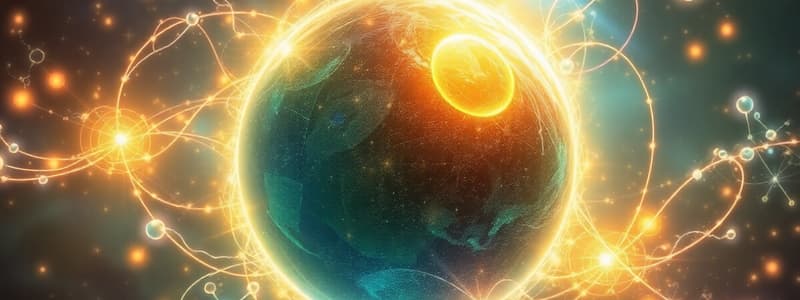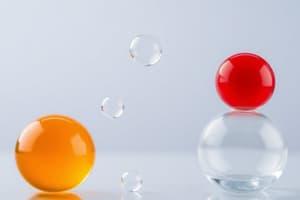Podcast
Questions and Answers
What charge do Group 7A elements typically form?
What charge do Group 7A elements typically form?
- -1 (correct)
- 0
- +1
- +2
Which of the following statements is true regarding Group 8A elements?
Which of the following statements is true regarding Group 8A elements?
- They form anions.
- They are highly reactive.
- They are unreactive. (correct)
- They readily form cations.
Which ion would you expect to be more stable based on its electron configuration?
Which ion would you expect to be more stable based on its electron configuration?
- Cl-
- S2- (correct)
- Na+
- Mg2+
How do metals on the left side of the periodic table tend to behave regarding electron loss?
How do metals on the left side of the periodic table tend to behave regarding electron loss?
What is the naming convention for a cation formed from a main group metal?
What is the naming convention for a cation formed from a main group metal?
What is the old naming convention for a cation with a smaller charge?
What is the old naming convention for a cation with a smaller charge?
Which ion is an example of a polyatomic ion?
Which ion is an example of a polyatomic ion?
What characterizes the ionization energy of metals compared to nonmetals?
What characterizes the ionization energy of metals compared to nonmetals?
What is the correct name for the compound NaCl?
What is the correct name for the compound NaCl?
Which of the following compounds is a Type I ionic compound?
Which of the following compounds is a Type I ionic compound?
What naming convention is used for Type II ionic compounds?
What naming convention is used for Type II ionic compounds?
Which statement about ionic compounds is correct?
Which statement about ionic compounds is correct?
How would you correctly name FeCl2 using modern conventions?
How would you correctly name FeCl2 using modern conventions?
What property allows ionic compounds to conduct electricity when dissolved in water?
What property allows ionic compounds to conduct electricity when dissolved in water?
What is the indication of a Type I ionic compound?
What is the indication of a Type I ionic compound?
When naming ionic compounds, which ion is listed first?
When naming ionic compounds, which ion is listed first?
What type of ion is formed when an atom loses one or more electrons?
What type of ion is formed when an atom loses one or more electrons?
Which of the following statements is true regarding the properties of ionic compounds formed by alkali metals and halogens?
Which of the following statements is true regarding the properties of ionic compounds formed by alkali metals and halogens?
What is the electron configuration of alkali metals in their neutral state?
What is the electron configuration of alkali metals in their neutral state?
How is the charge of a cation typically expressed in its chemical symbol?
How is the charge of a cation typically expressed in its chemical symbol?
Which ion formation results in a negatively charged ion?
Which ion formation results in a negatively charged ion?
What common characteristic do ionic compounds generally share?
What common characteristic do ionic compounds generally share?
Chlorine forms which type of ion when it gains an electron?
Chlorine forms which type of ion when it gains an electron?
What type of electron configuration do halogens have?
What type of electron configuration do halogens have?
What indicates that a polyatomic ion has a charge?
What indicates that a polyatomic ion has a charge?
What is the result of the ion-transfer reaction between sodium and chlorine?
What is the result of the ion-transfer reaction between sodium and chlorine?
Which of the following best represents how ionic bonds are formed?
Which of the following best represents how ionic bonds are formed?
What is a formula unit in the context of ionic compounds?
What is a formula unit in the context of ionic compounds?
How should the formula for an ionic compound be written?
How should the formula for an ionic compound be written?
When ions have different charge numbers, what is necessary for a net charge of zero?
When ions have different charge numbers, what is necessary for a net charge of zero?
Which of the following compounds forms from the reaction of calcium ions and nitrate ions?
Which of the following compounds forms from the reaction of calcium ions and nitrate ions?
What is the general relationship between the charges of cations and anions in an ionic compound?
What is the general relationship between the charges of cations and anions in an ionic compound?
What is true about the melting and boiling points of ionic compounds?
What is true about the melting and boiling points of ionic compounds?
Which of the following statements best describes the solubility of ionic compounds in water?
Which of the following statements best describes the solubility of ionic compounds in water?
What is the definition of an acid in terms of ion production in water?
What is the definition of an acid in terms of ion production in water?
What happens to the proton when an acid dissolves in water?
What happens to the proton when an acid dissolves in water?
Which of the following represents a hydroxide anion?
Which of the following represents a hydroxide anion?
What distinguishes different acids from one another?
What distinguishes different acids from one another?
Which base provides two OH– ions per formula unit?
Which base provides two OH– ions per formula unit?
Which of the following correctly identifies a property of bases?
Which of the following correctly identifies a property of bases?
Flashcards are hidden until you start studying
Study Notes
Ions
- Ions are formed when a neutral atom gains or loses electrons.
- Positively charged ions called cations result from the loss of one or more electrons.
- Negatively charged ions called anions result from the gain of one or more electrons.
- Alkali metals (Group 1A) form compounds with halogens (Group 7A). These compounds have high melting points, are stable, white crystalline solids, soluble in water, and conduct electricity when dissolved in water.
Ions and the Octet Rule
- Alkali metals (Group 1A) have a single electron in their valence shell with an electron configuration of ns1.
- By losing this electron, alkali metals become positively charged cations with a stable noble gas configuration.
- Chlorine and other halogen atoms have 7 valence electrons, and an electron configuration of ns2np5.
- By gaining an electron, halogens become negatively charged anions with a stable noble gas configuration.
Periodic Properties and Ion Formation
- Ionization energy is the energy required to remove one electron from a single atom in the gaseous state.
- Small ionization energy values indicate ease of losing electrons to form cations.
- Electron affinity is the energy released on adding an electron to a single atom in the gaseous state.
- Halogens have the largest electron affinity values and gain electrons most easily.
- Alkali metals lose electrons most easily.
- Noble gases neither lose nor gain electrons.
Naming Monoatomic Ions
- Cations are named by identifying the metal, followed by the word ion.
- Transition metals can form more than one type of cation. Two naming systems are employed for transition metals:
- Old System: The ion with the smaller charge is given the ending -ous, and the ion with the larger charge is given the ending -ic.
- New System: The charge on the ion is given as a roman numeral in parentheses right after the metal name.
- Anions are named by replacing the ending of the element name with -ide followed by the word ion.
Polyatomic Ions
- A polyatomic ion is an ion composed of more than one atom.
- The atoms in polyatomic ions are held together by covalent bonds.
- Polyatomic ions are charged because the total number of electrons differs from the total number of protons in the combined atoms.
Ionic Bonds
- Ionic compounds form when metals and nonmetals react.
- The opposite electrical charges of the ions attract each other, resulting in an ionic bond.
- Ionic crystals are held together by ionic bonds.
Formulas of Ionic Compounds
- All chemical compounds are neutral.
- Ionic compounds are neutral because the total positive charge of the cations equals the total negative charge of the anions.
- The chemical formula of an ionic compound expresses the ratio of anions and cations.
- If ions have the same charge number, one of each is needed to achieve neutrality.
- If ions have different charge numbers, unequal numbers of anions and cations must combine to have a net charge of zero.
Naming Ionic Compounds
- Type I ionic compounds contain cations of main group elements and do not require specifying the charge on the cation.
- Type II ionic compounds contain cations of transition metals that can exhibit more than one charge, requiring the specification of the charge on the cation.
- The charge on the cation can be indicated using either the old system (-ous, -ic) or the new system (roman numerals).
Properties of Ionic Compounds
- Ionic compounds have very high melting and boiling points. This is due to the strong electrostatic forces between ions.
- Many ionic compounds dissolve in water, but not all.
- The solubility of ionic compounds depends on the relative strength of the attraction between the ions and the water molecules compared to the attraction between the ions themselves.
H+ and OH- Ions
- Two of the most important ions are the hydrogen cation (H+) and the hydroxide anion (OH-), which are fundamental to the concepts of acids and bases.
- An acid is a substance that provides H+ ions in water.
- A base is a substance that provides OH- ions in water.
- When an acid dissolves in water, the proton (H+) attaches to a water molecule to form a hydronium ion (H3O+).
- Bases such as Sodium hydroxide (NaOH) and Potassium hydroxide (KOH) provide OH- ions in water along with the metal cation.
Studying That Suits You
Use AI to generate personalized quizzes and flashcards to suit your learning preferences.




